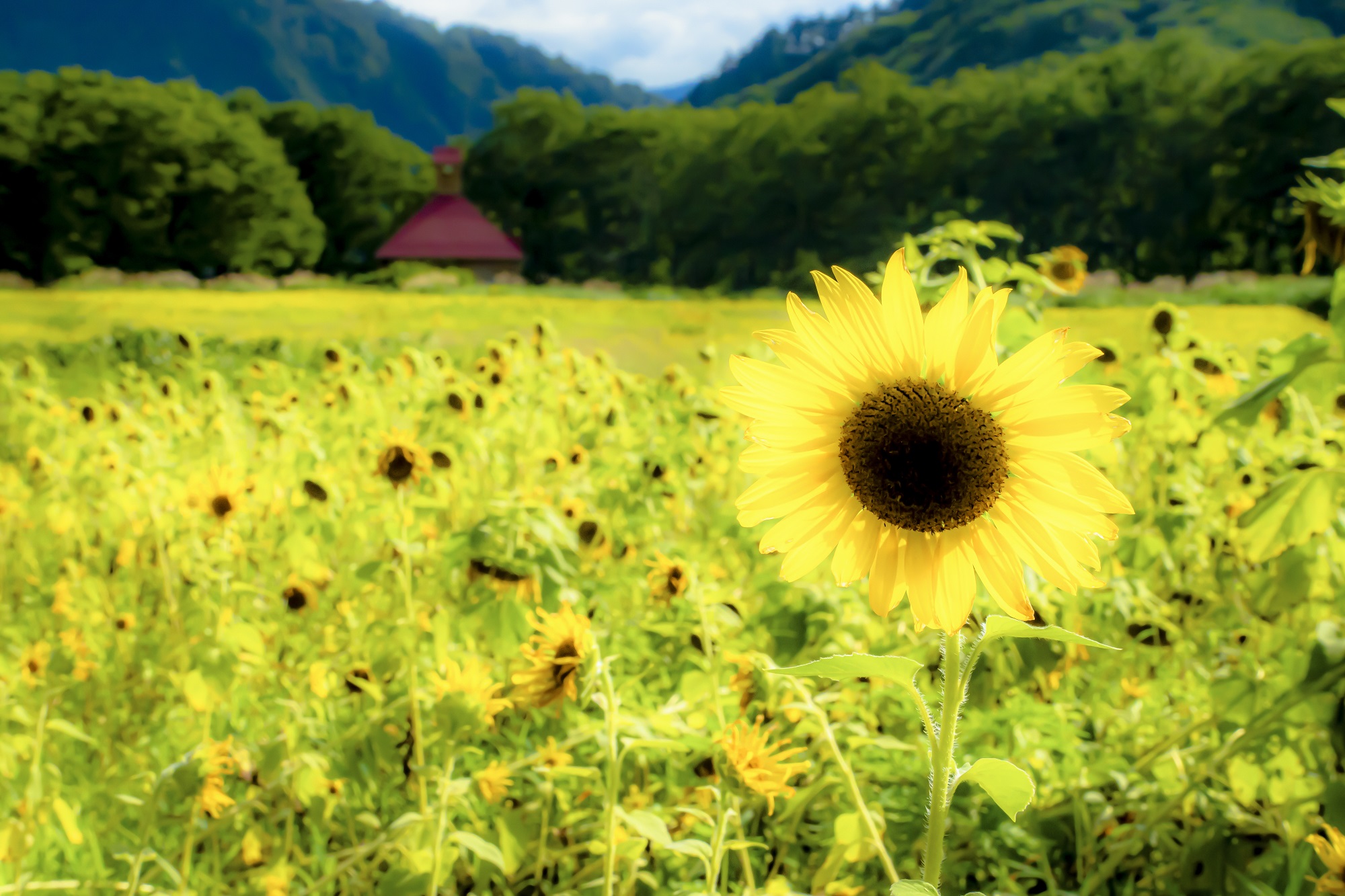
A revival of the FoodCamp that was unfortunately cancelled last year. Enjoy a course lunch with an abundance of local Oku-Aizu produce, such as Aizu-Jidori chicken and Kaneyama red pumpkins in the Misaka Highlands, right before sunflower high season. Chef Manabu Sato from restaurant ‘Teppanyaki Aizu-ya’ knows Aizu’s local products like no other. For the producer-visit, we will be welcomed by Aozi-jidori chicken farmer-, processor and seller ‘Aizu-Jidori Mishimaya’, and farmer of ‘Oku-Aizu Kaneyama Daishizen’-red pumpkins in Kaneyama. With the addition of a workshop of knitting-craft, this tour has a lot to offer!
Aizu-Jidori Mishimaya http://www.aizujidori-mishimaya.com/
Oku-Aizu Kaneyama Daishizen (Kaneyama Red Pumpkin) https://www.daisizen.biz/
Teppanyaki Aizu-ya https://magonotetravel.co.jp/besttable
Report
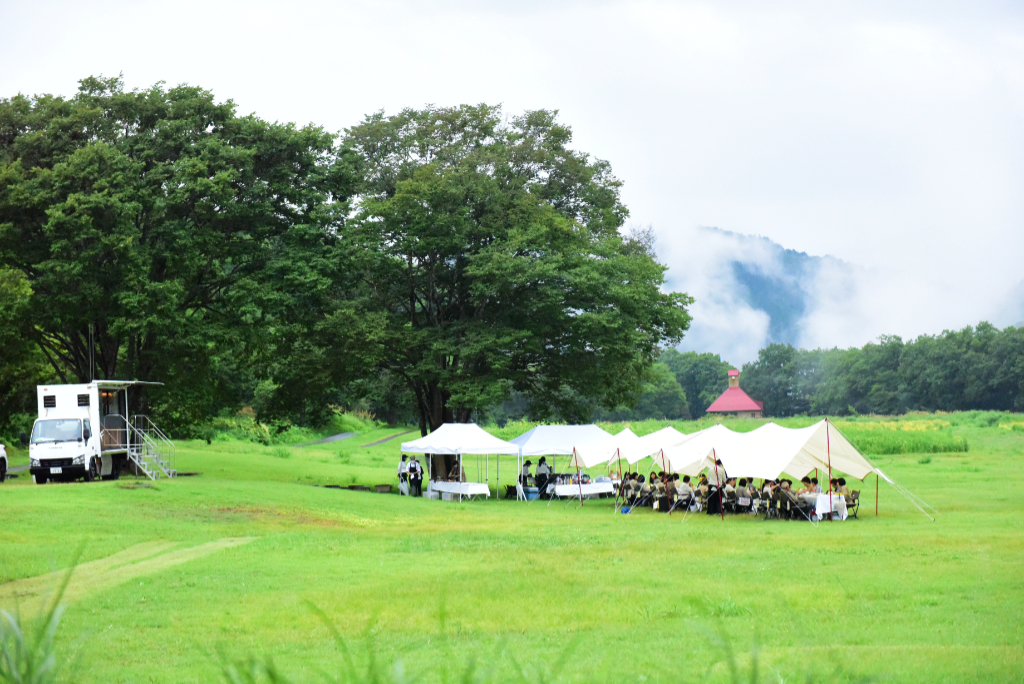
The Great Outdoors of Oku-Aizu
An edition of FoodCamp in Oku-Aizu was already scheduled for last year, but was unfortunately cancelled due to COVID-19. But our desire to have our guests witness the beauty of the sceneries and enjoy the wonderful food of Oku-Aizu did not waiver. Finally, FoodCamp’s Oku-Aizu edition became reality, and even better than originally planned.
The towns of Kaneyama and Mishima, located along the Tadami-river, make up the Oku-Aizu region, the stage for this edition of FoodCamp. Mountain-locked Kaneyama with its ‘Fairy Museum,’ as well as Mishima with its fog-filled gorge known as mugenkyo are increasingly recognized as tourist destinations. On the day, we were lucky enough to be overwhelmed by the mesmerizing sight of thick fog gently drifting over the Tadami river.
Kaneyama’s floating red pumpkins
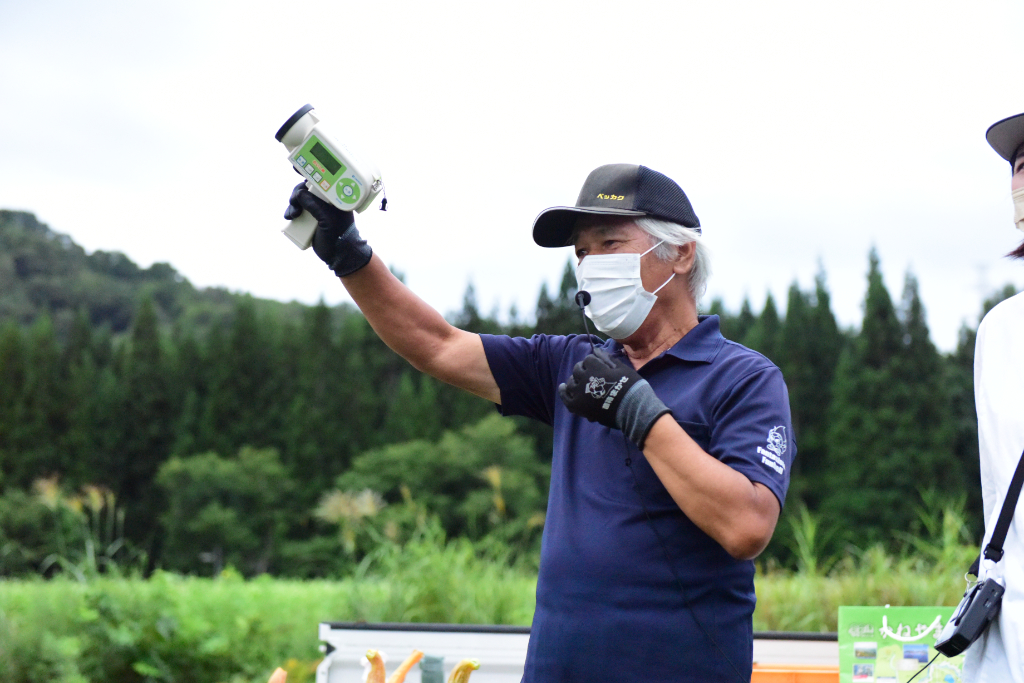
Mr. Oshibe, giving the green light to start the pumpkin ‘diagnosis’
Nothing says Kaneyama Town like its famous red pumpkins. These pumpkins are known for their deep orange color, relatively flat shape, thick stem, and their characteristic, and its protruding ‘bellybutton’ on the bottom end. Officially branded as Kaneyama Red Pumpkins, they are sold at a premium (around 700 yen per kilo). This also means that it’s not usually possible to enter their patches, but just for this occasion, we were given a very special opportunity to visit a patch filled with fresh red pumpkins. “I honestly don’t really want people to know the patch’s location, but…,” says Mr. Oshibe, owner of Kaneyama Red Pumpkins farm Daishizen, who nonetheless cheerfully give a tour of the patch.
As the guests enter the patch, their pleasant surprise is audible. The pumpkins are not lying on the ground, but rather hang suspended in mid-air, like round, orange lanterns. The vines from which the pumpkins hang are wriggled through an arch of pipes, offering a very interesting sight.
Mr. Oshibe gives a short lecture on the geography and climate of Kaneyama Town, as well as how to recognize well-ripened Kaneyama Red Pumpkins. And with that, the time was ripe for the guests to take a closer look, and find one pumpkin each that they think is just right to take home.
Kaneyama Red Pumpkins are subjected to strict standards before shipping, in terms of sugar-, water-, and starch contents, among other factors. Mr. Oshibe diligently checks the pumpkins handpicked by the guests for their sugar content. The pumpkins that make the cut get an official seal of approval. The voice of Mr. Oshibe and the cheers from the guests echo through the mountains, as Mr. Oshibe 0ut of the kindness of his heart gives guests who chose unripened pumpkins another shot, leaving all participants with an approved pumpkin to take home in the end.
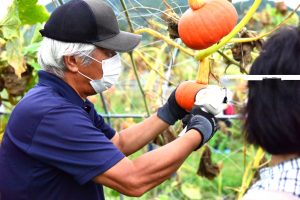
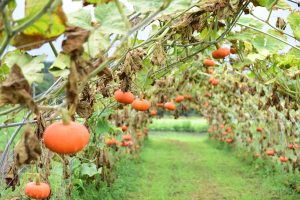

Mr. Oshibe even presented the guests with an original Kaneyama Red Pumpkins wrapping cloth!
What makes Aizu-Jidori chickens so great?
After all the excitement of the Red Pumpkins harvesting, it was time for the next highlight of Oku-Aizu: Aizu-Jidori chicken, one of the region’s specialties. Although unfortunately, we were not able to visit a chicken farm, the guests were shown a video explaining everything about Aizu-Jidori chickens on the bus while on the way to the dining location: the Misaka Highlands.
Mr. Kodaira, owner of Aizu-Jidori chicken producing-, processing and selling company Aizu-Jidori Mishimaya, was on-site to welcome the guests to the Misaka Highlands.
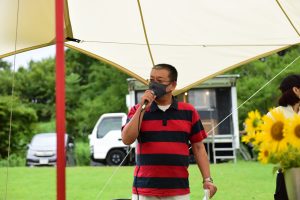
Aizu-Jidori chickens have a long history in Oku-Aizu, and have often been kept for aesthetic purposes. Because of their superior taste, Aizu-Jidori chicken is one of ‘Fukushima’s three brand chicken species.’ Aizu-Jidori are known for their strong and rich umami flavor, as well as their high imidazole peptide content; a substance in chicken meat that enhances fast fatigue recovery, making it well-suited for days of high activity.
Also, in order for the guests to still catch a glimpse of the beautiful chickens, everyone received one single feather together with their tour booklet. When sunlight hits the black feathers, it shows a distinct green glow. These beautiful feathers were also used to decorate armor, giving lead to the saying that ‘not a single part of Aizu-Jidori chickens should be thrown away!’
Fine dining in the middle of the highlands
The Misaka Highlands are located in Mishima Town, at an altitude of around 600 meters. It is a wonderful place to admire the sunflowers during summer or the changing leaves in fall. FoodCamp was planned to coincide with the sunflowers’ peak season, but they flowered a bit too early this year.
Nonetheless, we received permission from Mishima Town to pluck some of the last remaining flowers to decorate the dining tables.

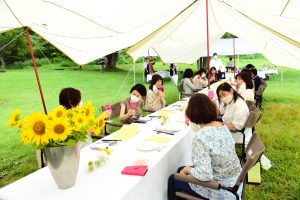
Although it was a bit rainy at times, underneath the tarp tent it was all the more comfortable. It was the perfect time to enjoy the not-too-hot, not-too-cold, refreshing climate of the highlands.
A chef who knows Aizu-Jidori through-and-through
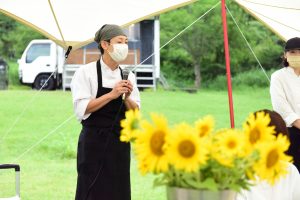
The meal for the day was provided by chef Manabu Sato from restaurant Teppanyaki Aizu-Ya in Aizu-Wakamatsu City.
Chef Sato has been using Aizu-Jidori chicken from Aizu-Jidori Mishimaya ever since he opened his restaurant. It’s fair to say he knows the quality of Aizu-Jidori chicken like none other. “The kind of aroma that spreads across the room when you saute it, you really only get with Aizu-Jidori chicken.” Chef Sato provided a menu made possible by his intimate knowledge of the deliciousness of Aizu-Jidori chicken.
Mr. Kodaira of Mishimaya, who always takes extra care of the chicken he provides to Chef Sato, takes place at the dining table together with the guests. He shows a big smile from start to finish, getting to hear how delicious his chicken is straight from the customers. As the organizers, this is one of the most rewarding parts of any FoodCamp.
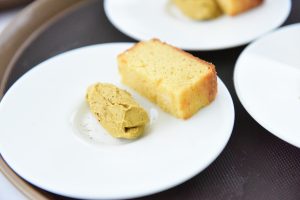
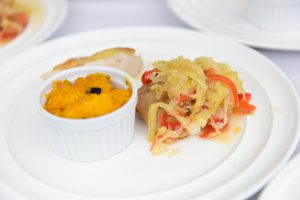
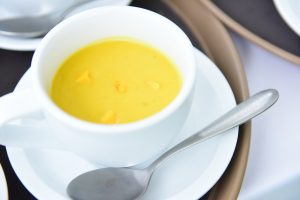
The Aizu-Jidori chicken pate, as well as the chicken saute that fully puts the meat’s quality to use, were especially popular.
Of course, there was room for Kaneyama Red Pumpkins in the menu. Exceptionally sweet!
Our company restaurant BestTable always comes up with the perfect original cocktails to go with the FoodCamp menu. This time, this included a perfectly bittersweet cocktail called Himawari, meaning sunflower, to go with the sunflowers of the Misaka Highlands. Especially its refreshing look made it very popular among the guests.
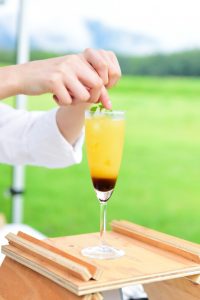
Feedback from the guests included: “Even though I live in Fukushima Prefecture, I’ve never had to opportunity to come here!” We hope we gave our guests the opportunity to get to know the locals, and fully enjoy the sceneries and culture Oku-Aizu has to offer. We are dedicated to keep offering opportunities to meet, experience and feel, in future editions of FoodCamp.
The rain had tapered off by the time we waved goodbye to our guests. Off to the next destination!
(Of course, the Misaka Highlands’ mascot bear had to be there too!)
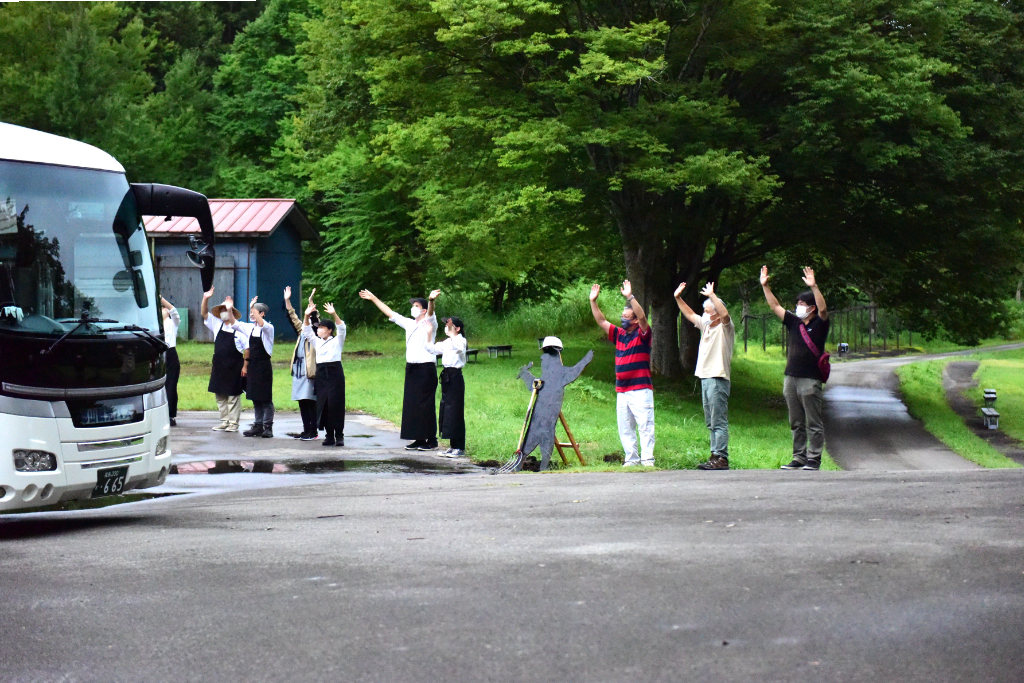
Highlights
-
Feel the summer among the sunflowers of the Misaka Highlands

Sunflower season in the Misaka Highlands. Have a fabulous meal of seasonal Aizu-produce, while taking in the refreshing breeze and sunlight in a sea of sunflowers.
-
Learn about Aizu-Jidori Chickens
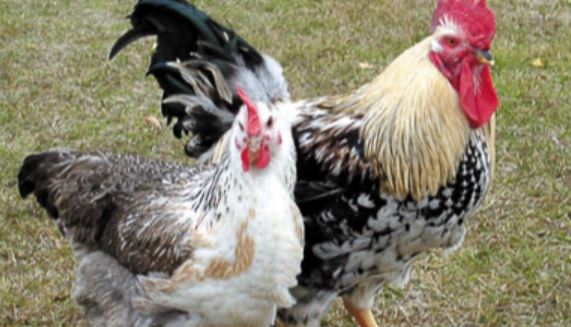
Take a lecture on Aizu-Jidori chickens from business owner Koizumi-san, who raises and processes them in Mishima Town.
-
Experience traditional Oku-Aizu braiding craft
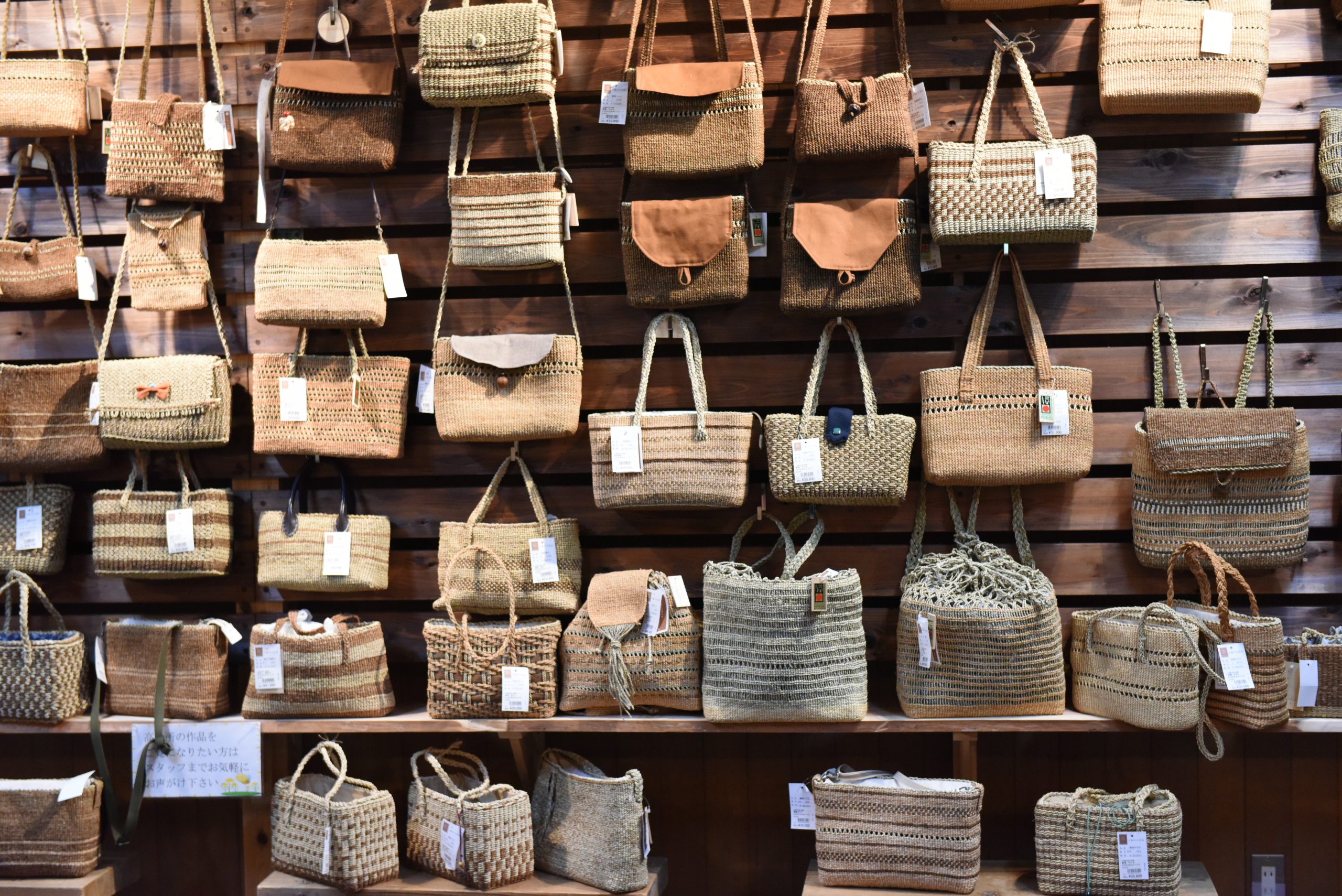
Oku-Aizu's braiding craft makes use of the vines and stems of the silver vine, chocolate vine, hiroro (carex multifolia) and crimson glory vine that naturally occurs in the area. Experience life in- and the warmth of the Oku-Aizu community through this delicate handicraft. Make your own works of braiding craft and take a look and get local souvenirs at the historical archive.
-
Producer visit no. 2: Kaneyama Red Pumpkins!
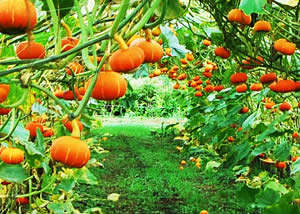
Kaneyama Red Pumpkins are absolutely delicious! The pumpkin patches, where the pumpkins hang from the vines like lanterns, are a true sight to behold. Let the pumpkin producer tell you all about growing as well as preparing red pumpkins. These pumpkins will surely be on the menu this year!
Cast
- Aizu-Jidori chicken's best feature is the sweet taste and elegant bite of its meat. Managing Director - Aizu-Jidori Mishimaya Co., Ltd. Kazuhiro KODAIRA
- The Aizu Mishimaya-company deals with everything from chicken breeding to processing and sales. Aizu-Jidori meat has a rich, sweet taste and a firm bite. Its history dates back over 500 years. Kodaira-san, the current president, equates his love for Aizu-Jidori chicken with his love for the region.
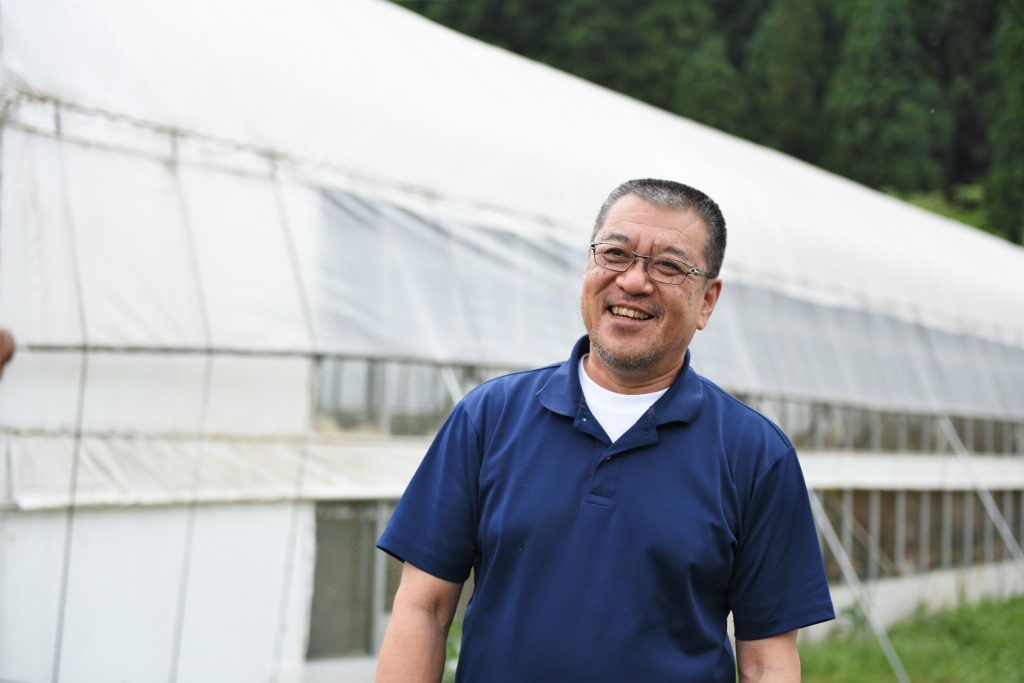
Discovering pure-bred Aizu-Jidori chickens
It is said that Aizu-Jidori chickes were first brought to the region by an Ochudo (a warrior exiled after a defeat) from one of Japan’s famous historical families, the Taira clan. The fact that the decorative feathers used during the Aizu-Higanjishi festival (dating back the 1570s) are in fact of Aizu-Jidori chickens, supports this theory. This means this species was already inhabiting the region over 400 years ago. In 1987, this then-critically endangered species started to be bred by a prefectural chicken breeding facility. It was during this experimental process that Kagoshima University learned that this species of chicken is completely different from hitherto known species. It evolved into its current state thanks to breeding processes. Aizu-Jidori chickens are large, delicious, and are even considered suitable for aesthetic purposes.
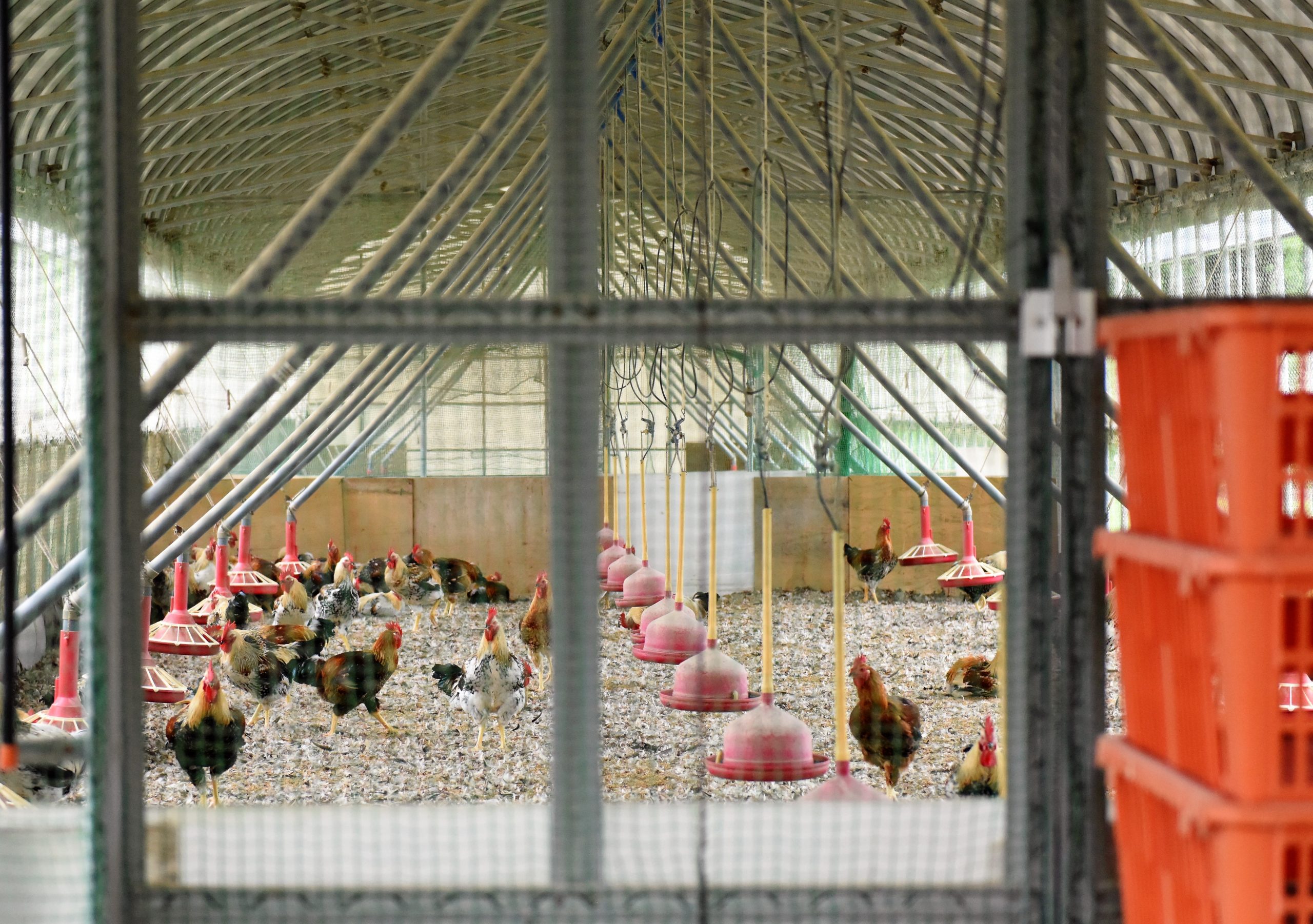
It started with a poultry-processing qualification
There’s a reason why Kodaira-san became the manager of Aizu Mishimaya. The town of Mishima designated Aizu-Jidori chickens as the town’s very own local specialty product, used to promote the town. However, in order to process the chicken meat, it had to be transported all the way to the city of Motomiya, making it only suitable for wholesale at first. Then, an idea began to stir: if the town had its own processing facility, that would mean the production, processing and sales could all be done from within Mishima. This grand task fell on Tokyo Agricultural University graduate and poultry-processing qualification-holder Kazuhiro Kodaira.
Kodaira-san’s mentor in college was an authority in the field of poultry-research, and some of his seniors in fact had been involved in this very research project. To Kodaira-san this felt like destiny. Aizu-Jidori is an established brand now, but in order for it to become that way, Kodaira-san received a lot of advice from his mentor in the early stages. After the 2011 disaster, the Oku-Aizu area faced the consequences of misinformation about Fukushima, despite hardly being affected. Nonetheless, the production volume currently exceeds pre-disaster levels. Koizumi-san has always kept his head high, standing by his chickens, with as sense of: “No worries, we can do this.”
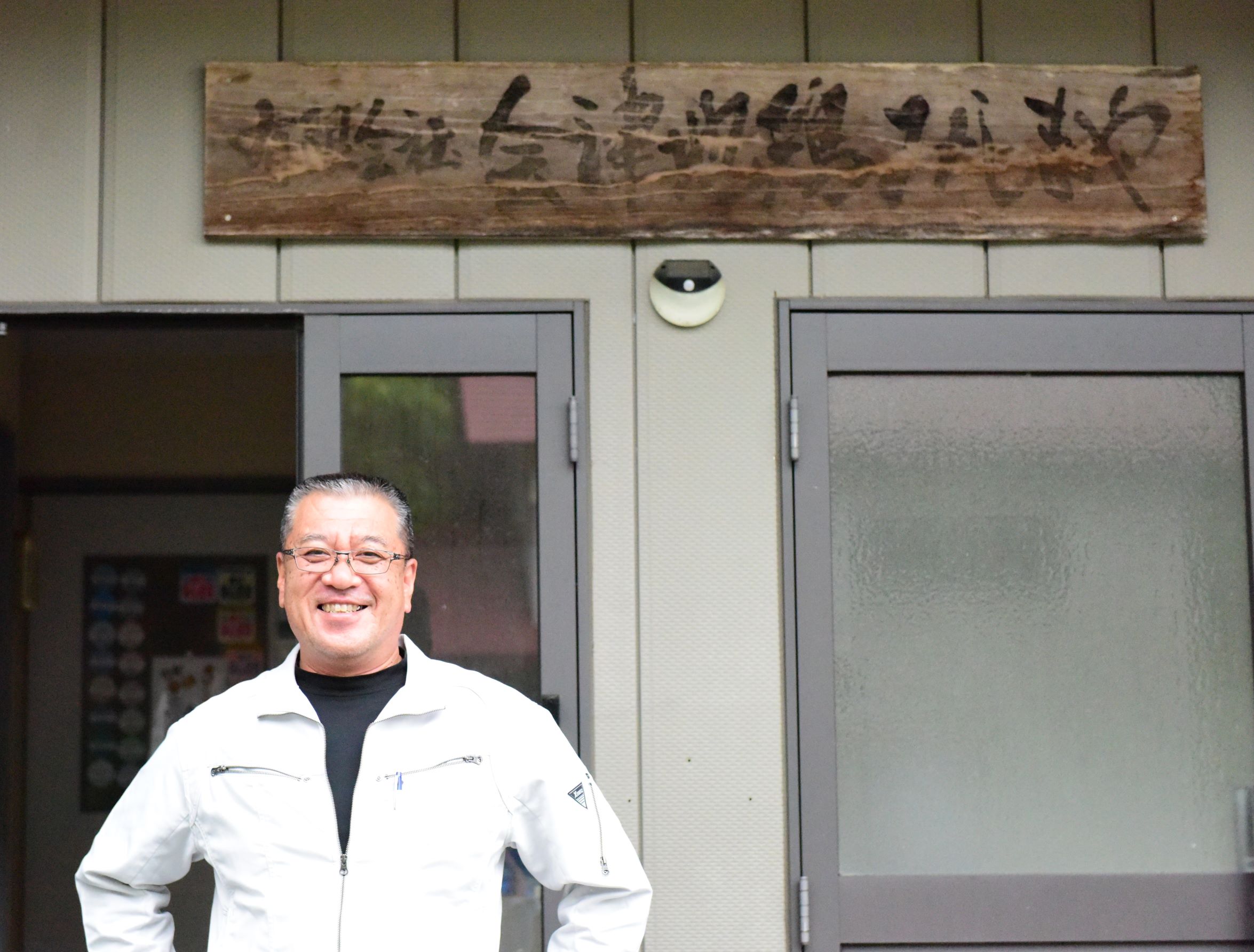
As Aizu-Jidori chicken is not shipped to general markets, Koidara-san had to get used to doing sales. There is a set method for raising Aizu-Jidori chickens, which tends to be quite costly, which is reflected in the rather high consumption price. This is why he turned to restaurants as an alternative route to market. Professional chefs have various very specific questions, which Kodaira-san ― thanks to his company both raising and processing poultry ― is easily capable of answering. He knows everything there is to know about the raising process, the qualities of the meat, and even differences in taste depending on the season. This is how he got restaurants to support his products, adding to the brand’s value. Kodaira-san always goes in head-on, with the kind of self-confidence and pride one finds readily in Aizu.
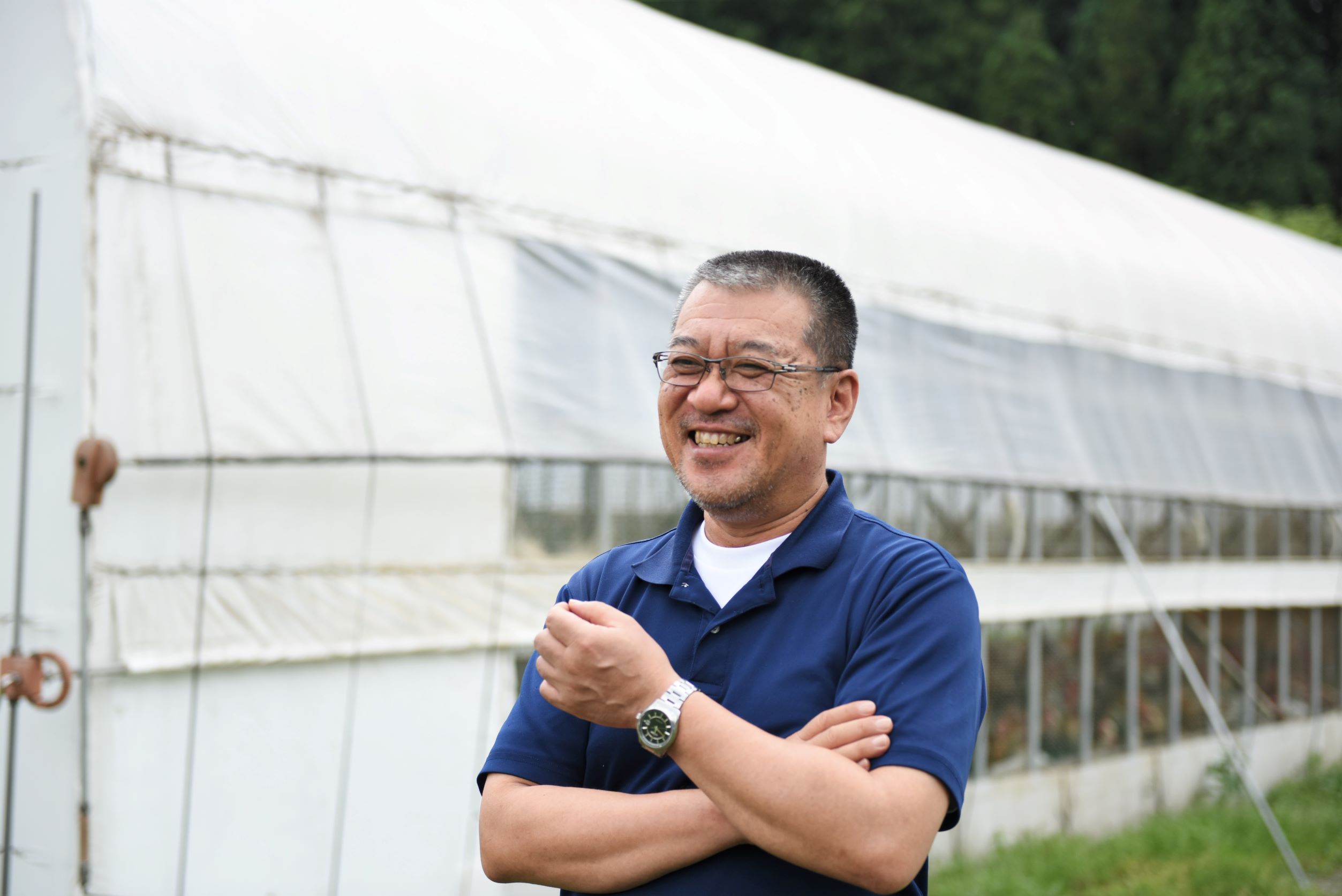
- The smell of Aizu-Jidori on the hot plate is irresistible. Chef, Teppanyaki Aizuya - Manabu SATO
- Chef Sato of restaurant Aizu-ya has been using Aizu-Jidori chicken from the very beginning. Kodaira-san is the producer he has worked with the longest. Together with Kodaira-san, chef Sato is dedicated to promoting Aizu-Jidori's quality, reflecting his deep feelings for Aizu's regional products.
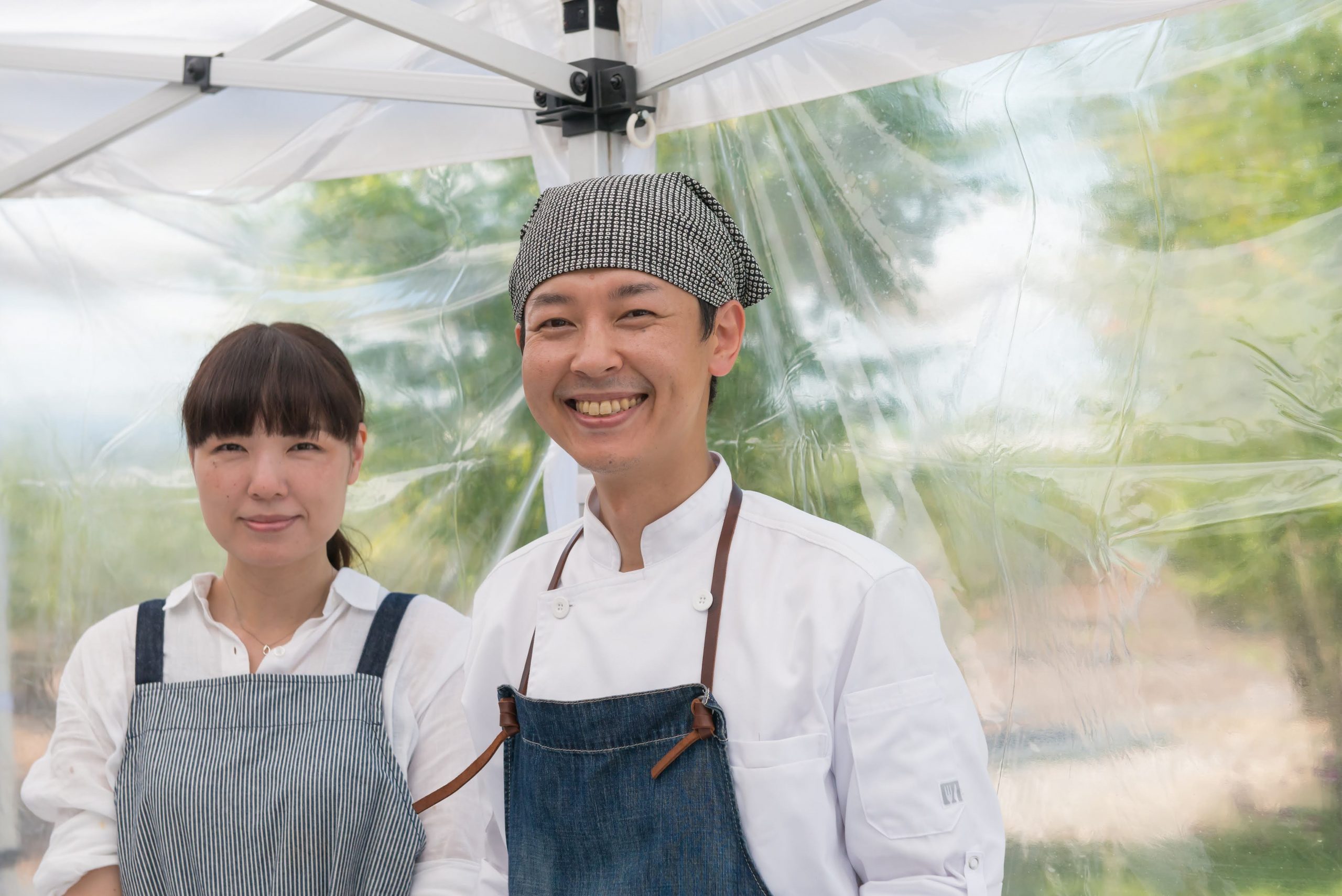
Not wanting to forget one’s early years
Born in Aizu-Wakamatsu City, Chef Sato moved away from his hometown to go to college. However, he felt things weren’t quite right, concluded that “if it’s just not for me, I should quit,” and dropped out. He moved back to his hometown and decided to pursue a career in something he had always loved: cooking. His parents recommended a French restaurant in Shimogo Town they had a connection with, called Chez Yamanobe. When he went to check out the restaurant for himself, he was moved by chef Yamanobe’s cuisine. So much so, he spontaneously asked the chef, “Please let me work here!,” which was turned down mercilessly. But he didn’t give up, and on his fourth try requesting the chef to take him in as a trainee he finally caved.
Yet, Chef Sato was only getting started on his culinary journey. He didn’t know how to properly hold a knife, had no relevant knowledge, and was, in fact, an absolute novice. “It was very difficult, and the work was quite hard. But it is the experience of that time that keeps me going now,” Chef Sato reflects. One of the dishes on Chef Sato’s menu, Jagaimo-Tsutsumiyaki, is one he learned during these years of training. He feels strongly about not forgetting about these early-career experiences.
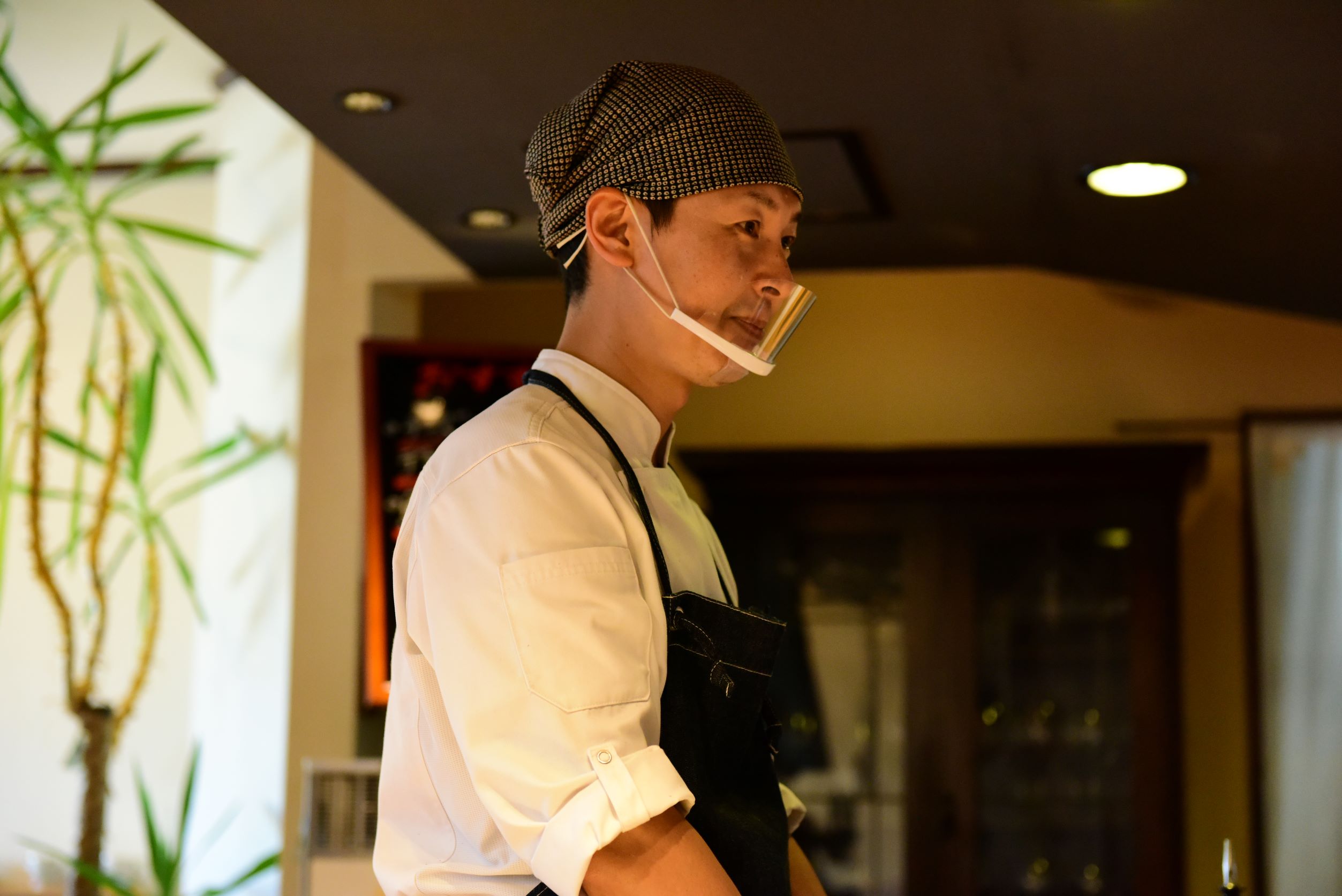
Opening up shop with a ‘re-discovering-Aizu concept’
In 2009, Aizu-ya officially opened. That time, there were not that many restaurants that specifically used local produce yet. Chef Sato is adamant about visiting farmers and talking with them first before using their products in his restaurant. “Before I choose to use products, I want to know more about them. I want to know the farmers’ character, about their land, and which of their products are especially delicious. That’s all,” says Chef Sato softspokenly, yet with a sense of firm belief.
In his restaurant, Aizu-Jidori chicken is wildly popular, thanks to its sweet aroma when grilled. Chef Sato fulfils an important role in conveying the taste of Aizu and that of the local food producers.

Chef Sato and Kodaira-san have been working together ever since the restaurant first opened. Kodaira-san was an acquaintance of Chef Sato’s father, and has since become the chef’s longest business partner. The respect Chef Sato feels towards Kodaira-san - as someone who shares his desire to bring high-quality Aizu-Jidori to the forefront, and as a fellow Aizu-citizen - is evident. They share a strong desire to embody the regional taste.
When asked about Chef Sato, Kodaira-san replies a little bashfully: “Every chef has their own preferences. Chef Sato explicitly chooses to use our meat, meaning he acknowledges its quality. As a producer, I am very happy that he shares our products with his customers,” conveying his sense of trust in the chef. We can’t wait for the participants of FoodCamp to share in the trust-based bond between these two!
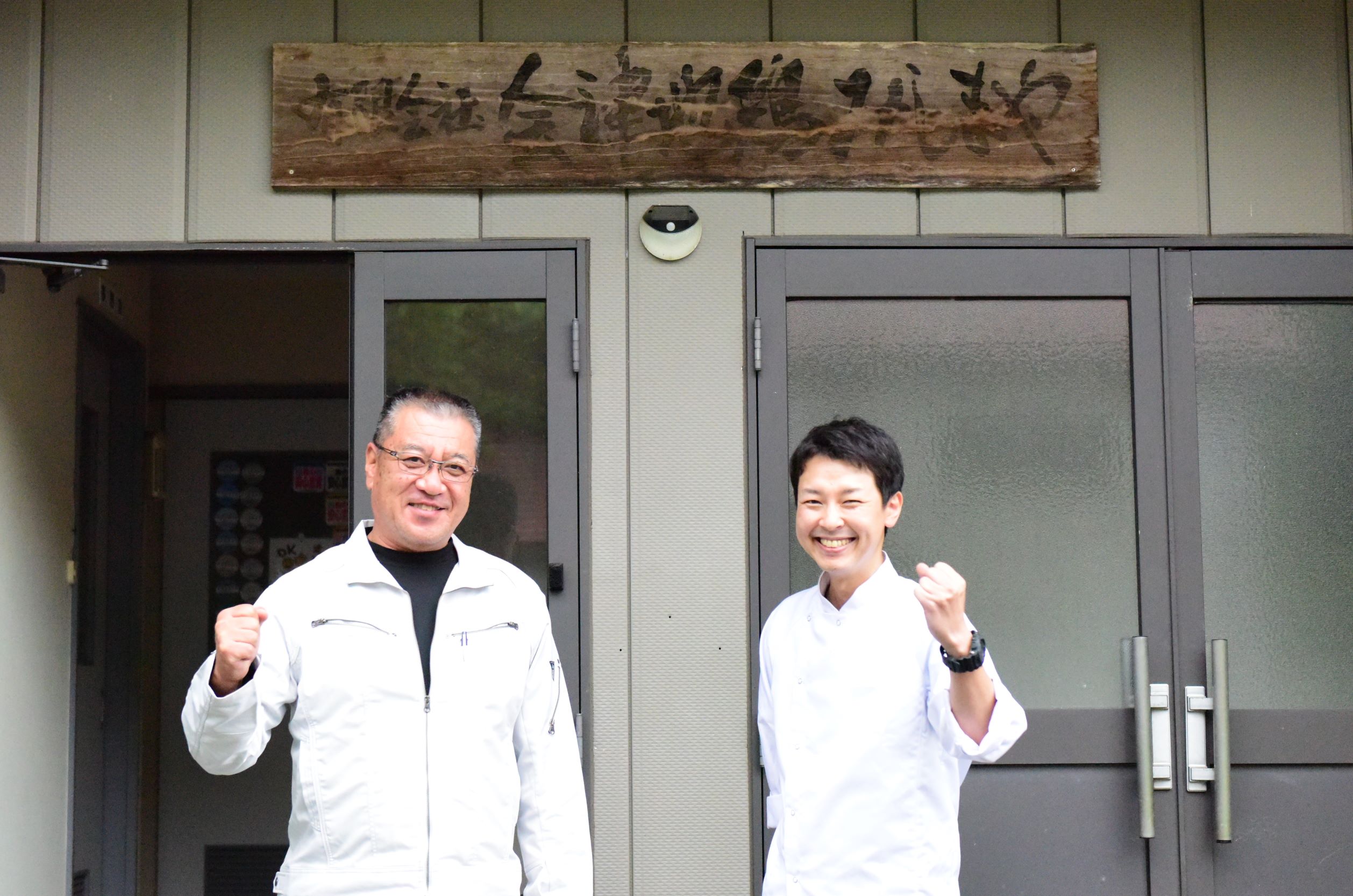
Tour Schedule
-
Pick-up / Meeting Place
8:30
Pick-up by taxi (Koriyama Kanko Kotsu Taxi) from your house or place of stay in Koriyama, or at Koriyama Station. We will inform you of your pick-up time one day before the tour (approx. between 8:20 and 8:50).
*For those scheduled for pick-up at Koriyama Station, please arrive at Koriyama Station by 8:20. -
Let's go!
9:00
Departure for the tour site, from the Magonote Travel Asaka Office. The bus will make a quick stop at Aizu-Wakamatsu Station (approx. 10:15). Those opting to join the bus in Aizu-Wakamatsu, please do so at Aizu-Wakamatsu Station.
* Those coming to the Office directly, please arrive by 8:50 (limited parking space). -
Arrival at the Kaneyama Red Pumpkin Patch
10:50
Pay a visit to a farm of the local specialty of Kaneyama Town in Oku-Aizu: Red Pumpkins! The lantern-like red pumpkins hanging off the vines is a sight to behold! Oshibe-san, producer and owner of the company Daishizen, will tell you everything about his products, its history and the production process. Finally, harvest your very own red pumpkins!
-
Mishima Town Local Crafts Museum
11:40
Learn about local Okuaizu 'Amikumi' basketry at the Mishima Town Local Crafts Museum. Many of the on-display craftworks (baskets, accessories, etc.) are available for purchase!
-
Long-awaited lunch at the Misaka Highlands
13:00
While on the bus to the Misaka Highlands, learn all about Aizu-Jidori chickens from Aizu-Jidori chicken producer Kodaira-san (Mishima-ya), including a quick look at the chicken farm from inside the bus. At the Misaka Highlands, a field of sunflowers will be ready to welcome you. The lunch will be provided by Chef Sato (Restaurant Aizu-ya), who has a strong connection with Kodaira-san. Enjoy Aizu's local produce to the fullest with a fabulous lunch course.
-
Departure & quick visit to the Mishima Roadside Station
15:30
After leaving the Misaka Highlands, make a brief stop at the Mishima Roadside Station 'Mishima-juku.' Fresh produce, processed goods and other souvenirs are available for purchase, as well as time for a bathroom break. Afterwards, the bus will head back to Koriyama.
-
Arrival at the Magonote Travel Asaka Office
17:30
After a quick stop at Aizu-Wakamatsu Station (around 4pm) , the bus will arrive at the Magonote Travel Asaka Office. You will be brought by taxi to your home or place of stay in Koriyama City, or to Koriyama Station.
*For those planning further travel by public transportation please prepare an itinerary from after 16:30 in case of departure from Aizu-Wakamatsu Station, or after 18:00 in case of Koriyama Station.
Tour details
- Date(s)
- August 20 (Sat.)
- Fee
-
*same rate applies for children/participants travelling to the venue directly with their own vehicle.Per person ¥18,800 *same rate applies for children/participants travelling to the venue directly with their own vehicle. - Tour Operator
- Magonote Travel's own staff will accompany the tour.
- Payment Method
- Please refer to "How To Apply" for more information.
- Travel Insurance
- Travel insurance is required for all tours, in case of accidents and emergencies. The insurance fee is included in the price. For this reason, we need to ask for your date of birth.
- Cancellation Fee
-
The following cancellation fees will be charged for tours with lodging and tickets: 20 to 8 days in advance: 20%, 7 to 2 days in advance: 30%, the day before the tour: 40%, on the scheduled date before the tour starts: 50%, no-show without notice: 100%.
For one-day tours, the following fees will be charged retroactively from the day before the start of the tour: 10 to 8 days in advance: 20%, 7 to 2 days in advance: 30%, 1 day in advance: 40%, on the scheduled date before the tour starts: 50%, no-show without notice: 100%. - In case of bad weather
- The tour will not be cancelled in case of bad weather. However, in case the tour has to be cancelled due to a natural disaster, you will be informed one day before the tour. In this case, you will receive a full refund.
- Terms and Conditions of Travel
- Please visit the ‘Terms and Conditions of Travel'-page.






